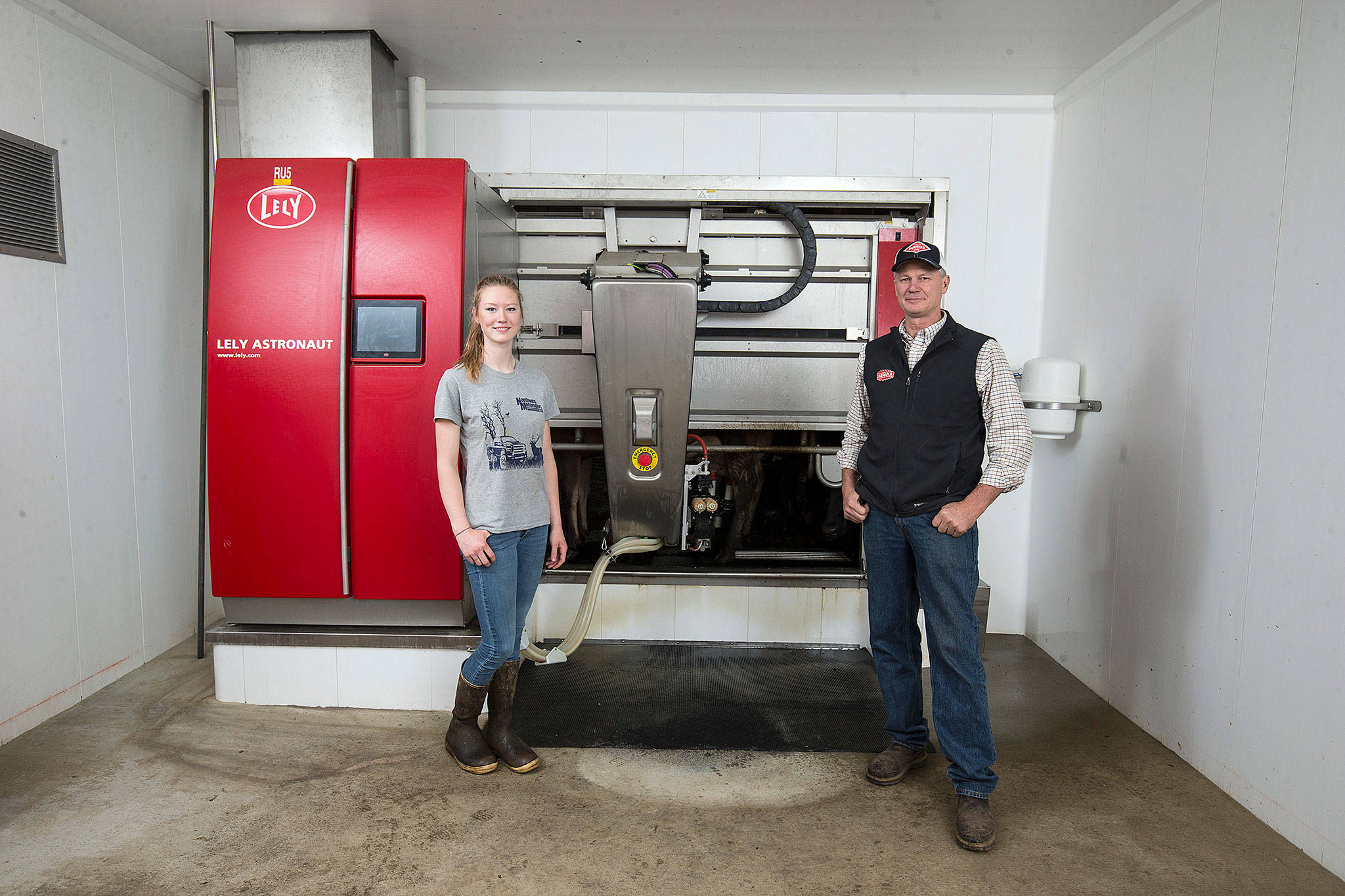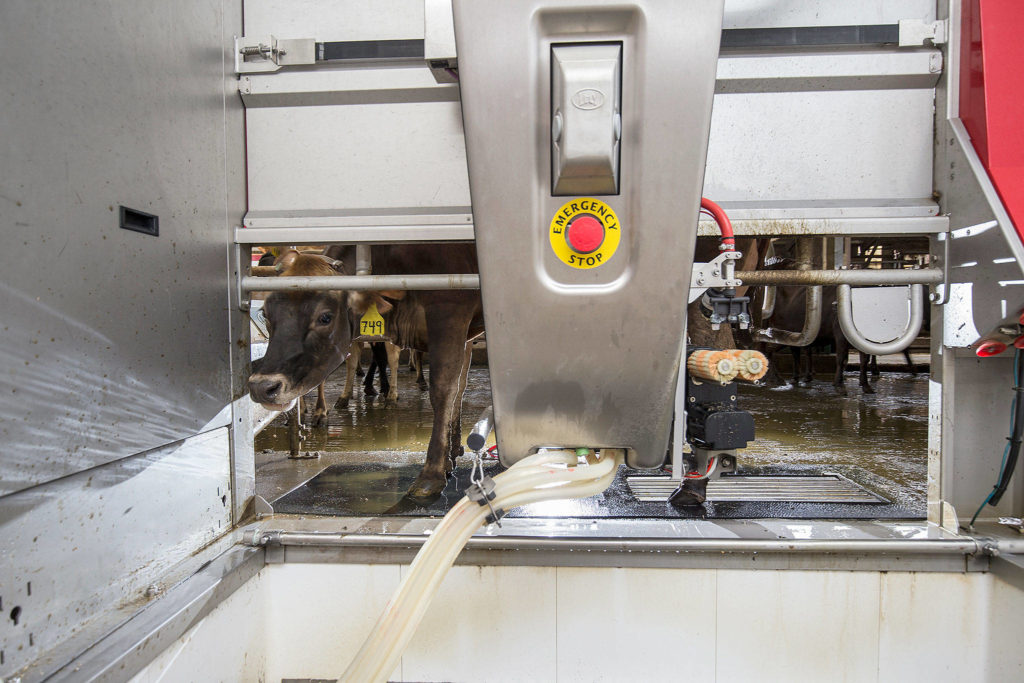The bright red, shiny robot would look more at home on a spaceship than in a Ferndale cow barn. But the cows aren’t fazed — in fact they line up for the chance to walk up to one of these cutting edge robotic machines and take their turn getting milked.
But it’s not just the cows enjoying the new technology — more dairy farmers are making the sizable investment to install new robotic milkers and other machines that increase efficiency and animal welfare while cutting labor.
In August, Leroy Plagerman installed eight Lely robotic milking machines on his Jersey farm of 450 cows in Ferndale. It’s the highest number of this particular brand of machine in the western U.S.
The installation meant a major redo of his barn. The machines alone cost $150,000 a piece. Then it cost another $32,000 to build each room the robot is housed in onto his existing barn.
At the same time, he also upgraded to an automatic flush system of cleaning out the barn — in which periodically water rushes through the entire barn and washes the cow waste away. In total, Plagerman said he put around $2 million into the farm.
“We’re investing in the future,” Plagerman said.
At the same time milk prices have been down. Plagerman said he’s getting paid the same price for his milk as he was 20 years ago.
But Plagerman, and many other dairy farmers, hopes the investment will pay off.
More than just milking
When a farm converts to using robots, it doesn’t just change the way it milks — the technology can have broad impacts on the entire way the herd is managed.
The basic way it works is at any time a cow chooses, it can walk into a chute and up to the robot. Some cows are skittish at first, but quickly learn that the robot dispenses grain feed.
The robot recognizes the cow by its sensor — basically a FitBit each cow wears around its neck — and immediately knows the last time it was milked.
If the cow goes in too often, going after that grain, the robot will reject the cow and open the other side of the chute and the cow will walk back out. The average cow gets milked three times a day, Plagerman said, but walks up to the robot seven times a day.
If a cow is eligible to be milked, the robot deploys brushes to clean the udder, then a laser-guided system guides the milking mechanism to attach to each teat.
The robot collects data on the process, including how much milk the cow gives and even the temperature of the milk, to keep tabs on the cow’s production and health.
When it’s done, the robot releases, disinfects the udder and opens the chute, letting the cow out. No humans are involved in the entire process.
The cows go in and get milked whenever they want, eat whenever they want, sleep whenever they want.
“The best thing for the cows is just to leave them alone and let them have their own space,” Plagerman said.
Plagerman expects that eventually, his overall production of milk will go up by an average of 3-4 pounds of milk per cow per day.
That’s because with the robotic system the cows are less stressed, so they produce more, and the individualized system allows the cows that are able to produce more to do so.
But the increase in production is just one part of the benefits the robots have had on his farm, Plagerman said.
Tracking health
The immediate impact he’s seen is on the reproduction end. The technology in the milker and the tracker the cow wears is more accurately able to determine when a cow goes into heat and when it can be bred.
The robot even selects and diverts the cows that are ready to be inseminated into a separate pen the next time they go up to be milked. The robots are much better at determining when cow can get pregnant than a human is.
“It’s amazing how accurate it is,” Plagerman said.
Before, 20 percent of the cows in a given 21-day time period that were eligible to become pregnant actually ended up getting pregnant. With the robots help, that’s gone up to 34 percent.
“A year from now, that’s really going to pay off,” Plagerman said.
Those same trackers, and some of the same stats, can also be used to monitor the cow’s health, and can alert the farmers when the cow is sick.
Plagerman has automated his farm in a number of ways. There’s the milkers, the flush system which cleans the barn, and another robot that ensures cows also have access to food.
Instead of feeding cows during designated meal times, now in the morning workers spread all the food the cows will need for the day in the aisle of the barn, so the cows can stick their heads through the fence and eat it.
A round robot with camera attached monitors the food, and when it gets too spread out it runs up and down the aisles, pushing it back to where the cows can reach it.
This allows the cows to eat whenever they want.
Tight labor market
“Basically this farm is run by two people now,” Plagerman said.
Previously, he had three full-time milkers and one part-time milker. His daughter, Jana, runs this farm now. Some of Plagerman’s sons work on the family’s other dairy farm, which has a 500-cow herd of mostly Holsteins and still has a traditional milking parlor.
Plagerman is a second generation dairy farmer, and he said part of reason for this upgraded technology was to keep his kids interested in taking over the family business.
“The idea is to work everything as efficiently and simply as we could,” Plagerman said. “You’re free to just manage the cows.”
He also did it because he was finding it increasingly hard to get the workers he needed.
“The challenge was the labor side of it,” he said. “Nobody wanted to do the 1 o’clock milkings anymore.”
Eventually they had to get rid of that shift altogether.
“(We) switched to two milkings per day because we had a hard time finding labor,” he said.
That difficulty is being felt by many dairy farmers, and farmers more broadly, said Scott Dilley, the communications director and a labor analyst at the Washington State Dairy Federation.
“One of the things we’ve seen in agriculture as a whole, and not just dairy, is the shortage of workers,” Dilley said.
In seasonal crops, there used to be a migratory cycle of workers who would move throughout the year to help with each crop as it became harvestable.
That cycle has slowed down dramatically in recent years, Dilley said, and workers just want to set down roots in one place and stay there. In that respect, dairy has an edge, Dilley said, because it’s consistent, year-round, full-time work.
But seasonal crops have an advantage — they can bring in guest workers from other countries through the H2-A visa program. But that’s for temporary work only.
“Berries, tree fruit can bring in temporary foreign guest workers; they can supplement the labor supply here in Washington,” Dilley said. “Whereas dairy, we have to compete for workers on the domestic market.”
As the labor market tightens, that competition is getting stiff. Many people are moving to cities, where jobs tend to pay more, away from rural areas, which have been slower to recover from the recession.
In the cities they’re finding a building boom, with construction firms that are offering higher wages and more benefits to entice workers.
“Back in the mid 2000s, especially when we had a shortage of workers in the tree fruit industry, it was hard because we had a lot of people leave agriculture and go to those other fields like construction,” Dilley said.
He said it’s possible that same thing is happening now.
And dairy farmers — who often don’t set their own prices — aren’t able to offer those same incentives to workers.
“The profit margin, which is already very, very thin, is getting even thinner,” Dilley said. “And that’s distressing for farmers to have to deal with. They can’t just pass on those increased labor costs to someone else.”
At the same time, new rules like the statewide minimum wage and sick leave law are making workers, if a farmer can find any, more expensive.
“There are those kinds of things that increase labor costs as well, and that’s one of the reasons farmers are turning to robotics,” he said. “Robotics don’t need a sick day.”
He thinks more farmers are going to invest in automated technology — if it pencils out amid the current low milk prices.
“Where there can be labor-saving devices like robotic milkers, they’ll adopt those labor saving devices more frequently,” Dilley said.
That means dairy farms in the future might have fewer workers, or they’ll be able to have more cows, or maybe just the existing workers will be more focused on other tasks.
Jobs dealing with animal care, especially raising calves and treating sick cows, still need the human touch and aren’t going to be automated anytime soon, Dilley said.
Regardless, more farmers turning to robotics isn’t going to cause a major disruption in the agricultural labor market, Dilley said, it’s going to be gradual.
“It’s not like there’s going to be a huge exodus of workers from dairy. I think you’re going to see people making these adjustments over time.”
Talk to us
> Give us your news tips.
> Send us a letter to the editor.
> More Herald contact information.


























